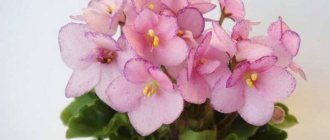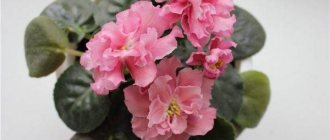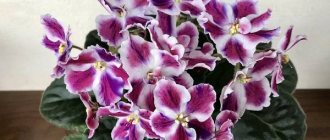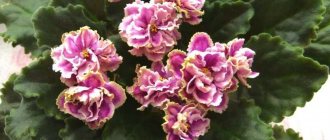Violet Emergency (Accident) delights its owners with bright semi-double or simple pansies in a bright red shade with a snow-white edging.
The variety belongs to large standards . The leaves are wavy, spoon-shaped, and have a red underside.
The rosette is flat ; in insufficient light, the leaves rise upward. When exposed to excessive light, the lower leaves become yellow.
Violet Emergency (K. Stork)
Emergency blooms with simple or double flowers . The flower is a blood-red pansy with a bright white border along the edge of the petal.
Saturation and brightness do not disappear even during the summer heat , which adds to the attractiveness of this variety.
Photo of Violet Emergence.
Despite the fact that the Emergency violet does not form a bouquet , it is in demand among collectors. Unlike many other varieties, Emergency blooms for a very long time, does not fade over time , and also maintains a white border regardless of the circumstances.
Each peduncle forms at least five buds . They are long and drooping. This is the only significant drawback of this variety. The flowering is long and lush, but collecting all the flowers in one heap is very difficult.
There is no variegation or imprints. The sheets are smooth, with a rich red underside.
When growing this variety, problems may arise with the formation of a rosette. She may resemble a spider.
The cuttings are very long and the leaves are crooked. This is a sign of going into sports. Such children are rejected at an early age.
Also, one of the signs of a genetic mutation is an excessive number of double flowers and the absence of simple pansies.
Violet Tatiana's Day (B. Makuni)
Wonderful violet Tatyana's Day.
Authorship of the variety
The elegant variety of snow-white Saintpaulia “Tatiana's Day” belongs to the breeding developments of Boris Mikhailovich Makuni , recognized by the entire Russian community of violet lovers as the master of domestic selection.
The author of this variety is Boris Makuni.
Violet belongs to the category of retro varieties, but has not yet lost its charm.
Taxonomy
Violet “Tatyana’s Day”, according to the principles of hierarchy in scientific-taxonomic typology, joins the genus Saintpaulia (family Gesnerieceae), which is enormous in terms of the number of varieties included in it
The presented variety belongs to the terry subspecies.
- Based on the diameter and overall dimensions of a bush that has grown to a mature state, the violet can be called a “standard” variety;
- Based on the mass of petals included in the flower, it is a double subspecies;
- And judging by the color of the buds, this is a group of rare snow-white Saintpaulias.
Photos and description of decorative features
Saintpaulia is one of the most luxurious white-flowered varieties . It is distinguished by its ability to independently form spectacular bushes of standard sizes according to overall typology.
The undoubted advantage of the variety is the compact configuration of the rosette of leaves - most violet growers suffer from a lack of space in their collections, and the neat size of the violet is always a priority when choosing a variety.
Slightly elongated leaf petioles at a young age give the violet a loose structure , but after the bush is fully formed, this minor defect disappears by itself, as the rosette acquires sufficient density.
have a round shape :
- Small pointed nose;
- The surface is smooth;
- Shiny structure;
- Quite large;
- With soft semicircular serrations along the edges of the sides;
- And an impressively embossed venation pattern in a light green color.
The wavy structure of the contours can give the leaf plate the outline of a shallow boat .
The color of the leaves is distinguished by the tonality of dark green , while their reverse side is illuminated by a silvery haze with a clear reddish tint. The leaves of young violet specimens may have a shade of summer green with a light lining on the underside, but over time the color darkens significantly.
The violet blooms very magnificently on Tatyana's Day.
The violet blooms very richly, with magnificent foam caps . But the full scope of the varietal description of flowering is not achieved immediately, but from flowering to flowering. Violet growers are always pleased with the significant size of the flowers, characterized by a double degree of filling, and the waviness of the petals, which increases the overall grandiose volume.
Along the edge of each petal there is a thick fringed edge - another factor enhancing the overall impression .
ATTENTION! The unique snow-white corollas of violets deserve special description, which, when fully opened, can demonstrate the most delicate lilac illumination of their center, as well as a thin frill of a salad shade on the edges of the fringe.
The variety in question has snow-white flowers.
Sports
retains its varietal characteristics quite well . Only sometimes a light lilac tinting of the central part of the corolla can acquire an intense color of bright lilac and paint over an entire petal with this paint.
Occasionally, a purple color appears on white flowers.
Caring for a plant at home
The variety is capricious and its maintenance requires experience and skills. It cannot be said that if this plant falls into the hands of a beginner, it will die, but there is no guarantee that the violet will form a correct and beautiful rosette.
It is very important to get the lighting right . If there is too little light, the violet begins to pull the leaves up. With too much light, the lower leaves begin to age prematurely and die.
Proper watering and fertilizing
This variety does not tolerate wick watering. Does not like excessive humidity. It is best to water from below or at the root.
Saintpaulia Emergency does not like too much fertilizer.
If you overfeed her, then instead of pansies she will produce double flowers, which will not be a sign of sport.
Lighting and temperature
Violet prefers natural light. Loves diffused light, but can also feel fine when exposed to direct sunlight.
At the same time, it reacts poorly to heat. Flowers in such conditions do not float and do not fade. The color becomes more saturated over time and the petals acquire a crimson hue.
In order to form a beautiful rosette, you need to experiment with lighting and, if necessary, tear off the lower leaves if they begin to pull out cuttings.
Attention! Good lighting must be provided from early childhood.
Air humidity
Emergency violet is unpretentious, but does not tolerate excessive humidity . It is enough if this figure fluctuates between 50-60%.
Transplantation rules, selection of soil mixture
Violet can be replanted in autumn or spring. It is best to do this in February. After transplantation, the plant will have time to take root and bloom in a timely manner.
In summer or early winter, it is better not to replant violets ; they do not take root well. This can only be done in an emergency, when the plant is sick or has been attacked by parasites.
Soil composition:
- 2 parts leaf soil;
- 1 part of coniferous land;
- 1 part of turf land;
- 1 part peat;
- 1 part crushed sphagnum (this is moss);
- 0.5 parts sand (preferably river);
- a small amount of charcoal.
The soil mixture should allow air to pass through well and not retain moisture.
Pruning and hygiene
Saintpaulia Emergence requires constant care. In order for the rosette to be smooth and beautiful, it is necessary to control the size of the rosette from a very early age.
If it turns out that the petioles of the lower leaves have become too long, they are removed.
Advice! It is also worth removing faded buds and flower stalks.
Reproduction methods
Most often, this violet variety is propagated by leaf cuttings. It takes root readily and produces a large number of children. Sports are formed quite rarely. They can only be noticed after flowering. Specimens with crooked leaves are also rejected. This is considered a genetic mutation.
If side shoots (stepchildren) , then they can also be rooted and a new plant can be obtained.
Rules for transplantation and variety rejuvenation
When transplanting a young plant, it is transferred to a larger container.
An older plant requires more attention. Part of the root system is slightly removed using disinfected scissors, and then the cuts are sprinkled with crushed coal.
You can remove a third or even half of the roots. Over time, the violet will grow young roots and the plant will become healthier.
If the rosette is old and has a stem that is too high, which spoils its appearance, then it can be rejuvenated:
- The plant should be cut at soil level;
- Carefully scrape the top part of the bark from the surface of the stem, sprinkle with crushed coal and place in water;
- After 15-20 days, the rosette should form roots;
- After this, the plant is transplanted into a new pot.
Features of flowering, growth and reproduction
The petiole produces a sufficient number of children, which quickly take root and develop. , 8-9 months can pass
Most often, the variety is propagated by the leaf method, but if the rosette has produced a lateral shoot, it can be successfully rooted. Sports rarely give , they can be noticed immediately by the uneven curly leaves.
Gives good and abundant flowering even in the heat. Doesn't fade or float. Doesn't like too high a temperature, but holds the rich color well.
Prefers good natural light. It is best to place it on the east or west side. Can tolerate direct sunlight in the morning or evening.
The peduncles are long, lie haphazardly and deviate in different directions. It is very difficult to achieve lush cap blooms from this variety.
It blooms for a long time and a lot, but you should control the length of the peduncle using lighting. If you feed a violet, double flowers will appear instead of pansies.
Features of cultivation
When growing violets of this variety, flower growers are protected from the occurrence of unpleasant nuances, since the variety is characterized by calm, balanced behavior in relation to the agricultural technology used.
Features of development in the microclimate of the room
The violet variety stands out:
- Non-capriciousness of character;
- Easy perception of the microclimate of the room;
- Standard terms of development;
- And exquisite decorativeness.
The characteristics of the variety are designed to preserve the fresh appearance of Saintpaulia corollas for a long time, which greatly pleases flower growers.
Other favorable features of the violet’s appearance include:
- Self-help in forming a socket;
- The chic decorativeness of a variegated bush;
- A magnificent combination of non-standard shape and pastel colors of the corollas;
- Strong flower stems.
The nuances of development include:
- A long period of preparation of buds for flowering and their long opening;
- The structure of leaf plates with raised edges;
- Disappearance of the goblet shape with full dissolution of flowers;
- Keeping the bushes cool is useful for preserving the variegation of the rosette and maintaining the goblet-shaped structure of the corollas.
Specifics of reproduction
It is possible to use propagation only by vegetative means :
- Children;
- Leaf cuttings;
- Layerings of an adult specimen.
ATTENTION! Violet has good fertility.
Temperature
When keeping a plant in a hot home microclimate, excessive heat can cause a change in the color of the corollas - pastel shades can become more intense in color.
To maintain the decorative integrity of flowering specimens, it is recommended to provide them with cool conditions , but protect them from sudden changes in the temperature gradient and drafts.
Peduncles
The violet develops strong flower stalks :
- Strong construction;
- And the optimal length;
- Capable of firmly supporting the caps of terry corollas in an upright position.
Flowering type
Varietal violets gradually begin to form voluminous caps , reaching maximum size and splendor with age.
Vitality of flowers
Saintpaulia blooms for more than two months.
The corollas can maintain the freshness of the decorative format for more than two months .
Reviews
Raisa, Moscow. “I grow all the children that the cutting produces. As they grow, I select specimens with the most compact sockets. I delete all the others. The phenomenon of spider legs is quite common among violets. It was standing on the windowsill, but now I put it under the lamp and double flowers appeared.”
Karina, Mariupol. “My violet’s rosette has reached 30 cm. It’s the only one among all varieties. I decided to break it off a little to check the size. If it is too light, the leaves immediately begin to lift up. I don’t use a pot larger than seven, otherwise she will grow up to be a real elephant.”











